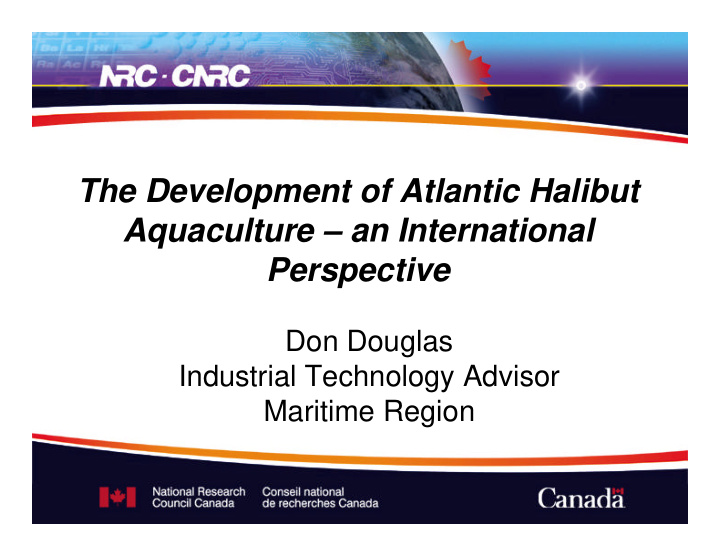



The Development of Atlantic Halibut Aquaculture – an International Perspective Don Douglas Industrial Technology Advisor Maritime Region 1
Stages of development of aquaculture of new species • 1. Can it be done? (scientific challenge - very large risk) • 2. Can it be done reliably? (technology challenge – substantial risk) • 3. Can it be done reliably and make a profit ? (both a business and an optimization of technology challenge – more manageable risk) 2
Aquaculture of Atlantic Halibut • Until approximately 20-25 years ago – total uncertainty of ability to bring halibut into culture • About 10 years ago – evidence of sporadic success but largely unreliable, particularly in terms of juvenile production • Over the past 5 years, growing evidence of reliable production. The focus is now on the development of the best possible models for successful commercial production 3
An International Perspective • There have been rumours that the northern European countries have backed off on investment and activity in aquaculture of Halibut Wrong!! In fact, there is strong evidence of: • Development of major strategic international partnerships (incl., for juvenile production) • Development of sophisticated grow out technologies, incl. both on land tank and sea cage culture 4
Some of the European companies visited • Iceland – Fiskeldi : hatchery, nursery and growout operations) • Norway – Nordic Seafarms and Marine Harvest Rogaland ( Nutreco/Skretting ): nursery and grow out facilities • Scotland – Otter Ferry (juvenile production), Kames Halibut Farms (grow out) and Marine Harvest (Nutreco/Skretting): nursery and grow out) 5
Some examples of commercial-scale growout • On land tank farms – ex-salmon tank farms adapted for later stage (e.g., from 300-1000 g) nurseries. Typically with sunshade covers, shelves, autofeeders and camera systems. • Sea cage culture – modified salmon cages with covers, bottoms, shelves, autofeeders and camera systems. Both: • large steel cage arrays • independently moored, poly polar circle cages 6
Summary Strong evidence in Europe of: • Major confidence and recent investment in Halibut aquaculture • Formation of strategic international partnerships • Widespread adoption of sophisticated culture technologies • Expansion of on land facilities and sea cage sites, and SUCCESS!! 7
Acknowledgements To the senior management, site managers and staff for allowing site visits and open sharing of information: • Fiskeldi Group , Iceland • Kames Halibut Farm , Scotland • Marine Harvest , Scotland • Marine Harvest Rogaland ( Skretting ), Norway • Nordic Seafarms ASA , Norway • Otter Ferry , Scotland 8
Recommend
More recommend